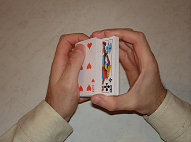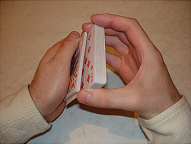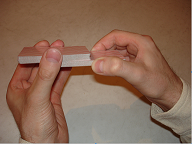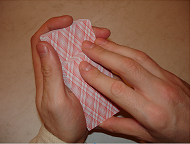Fundamentals of mechanical engineering
This section is devoted to the simplest techniques, without which you can not deal with card tricks.
These techniques are used for several centuries and are the basic elements in card magic.
In some other sections, these techniques are considered more carefully.
How to shuffle the cards.
Every person who has ever played cards knows perfectly well what shuffle is and how to shuffle cards.
Therefore, in this section I will describe the most popular and common shuffle cards.

Take the pack in the left hand so that the long edge of the deck lies at the base of the fingers of the left hand.
The thumb of the left hand is on the top card shirt, and the tips of the other fingers are on the left side of the bottom card of the deck.
Further, with your right hand, take the deck, lift it up, while the left thumb pulls a part of the cards from the deck, leaving this part in the hand.
After that, with your right hand, do a few movements up and down, lowering and raising the cards and the palm of the left hand, on top of the cards that are already in the left hand.
Each time the cards fall into the palm of the left hand, the thumb of the left hand pulls one or more cards from the right hand.
This process continues until there are no cards in the right hand.
Then the shuffle is repeated.
In the process of shuffling, you can not look at the cards.
The shuffling speed should be average, the rate of shuffling should be uniform.
Practice shuffling until shuffling becomes a habit.
Control of the top card.
This technique allows you to leave the top card on top of the deck after shuffle.
To do this, take the deck and start shuffling in the usual way, and make sure that the thumb on the left hand pulls only one top card from the beginning of the shuffle.
After this, without stopping, continue shuffling the cards until the deck is finished.
As a result of these actions, the top card will go under the bottom of the deck.
Then shuffle the cards again so that the last card in the right hand is left alone, and you casually throw it to the top of the deck.
So, as a result of two held shuffles, the top card remained on top of the deck.
When using this technique, it is necessary not to focus the audience's attention on shuffle, but use psychological techniques.
The shuffle should pass as if by itself and there should not be the slightest accent on shuffling the cards.
Control of the bottom card.
This technique allows you to leave the bottom card at the bottom of the deck after shuffle.
To do this, take the deck and start shuffling in the usual way, with the thumb of the left hand pulling some of the cards from the top of the deck and at the same time the middle and ring fingers of the left hand pull the bottom card.
The remaining cards are shuffled in the usual way.
As a result of using this method, the bottom card remains in its place.
Control of the top and bottom cards.
This method allows you to leave the top and bottom card of the deck after shuffle in its place.
To do this, take the deck and start shuffling in the usual way, with the left hand pulling together the upper and lower cards, and continue to shuffle the deck in the usual way.
Then align the cards in the deck and repeat the shuffle again, also pulling the top and bottom cards at the beginning of the shuffle.
Then continue to shuffle until one card is left in the right hand, which rushes to the top of the deck.
As a result of using this method, the lower and upper cards will remain in their places.
This trick can be used to save two lower cards and one top card in their places.
Control the top of the deck.
This technique allows you to leave the top of the deck after shuffle in its place.
This is done as follows.
To do this, take the deck and, before shuffling, pull off the top of the deck, which must be left in place, then pull together only one card using the "protrusion" technique, which is described below.
Then continue to shuffle the remaining deck in the usual way.

After the end of the shuffle, the card that will perform will mark the place where the former top cards of the deck lie.
Then, with your right hand, raise the deck from the left hand, and the thumb from the right hand presses the protruding card forward, simultaneously poking it into the deck so that a small gap is formed in this place.
With your right thumb, hold this slot and begin shuffling the cards until you reach this slot, after which all the cards that are left in your right hand are thrown up the deck.
As a result of using this technique, the initial top of the deck will remain in its place.
Chess (jogging).
This term means a special shuffle of cards, which is used as an auxiliary.
When using this shuffle, the cards are tightened one by one.
To do this, take the deck, and starting the shuffle, press the thumb of the left hand to the shirt of the deck, the right hand raises the deck, and the thumb of the left hand pulls only one top card.
After this, the deck goes down and the thumb of the left hand pulls back only one top card.
Thus, the cards are shuffled until the entire deck is finished.
Usually this method of shuffling is used to pull together one or two cards, in rare cases 6 cards, and shuffle the entire deck, pulling together only one card, there is no need, because this shuffle looks unnatural and only causes suspicion among the audience.
This shuffle is very useful to use, so that the fingers have acquired the necessary sensitivity and lightness, which is needed in almost all shuffles.
To use this shuffle you need cards in very good condition.
The ledge (ingzhog).
This method allows you to keep a certain place in the deck under control.
To do this, take the deck, start the shuffle and during the shuffle the right hand slightly shifts towards the body, the thumb of the left hand pulls one card so that it protrudes slightly from the inner edge of the deck.

After this, the right hand moves forward to its initial position and continues the shuffle in the usual way.
The result is that one card will protrude from the inside edge of the deck.
Then continue the shuffle in the usual way, and the cards need to be shuffled somewhat unevenly, with a shift forward and backward in order to disguise the protruding map.
During the execution of this method, you can not look at the cards, it is necessary that the little finger on the left hand feel the situation and determines that the card that has played has taken the correct position.
With long workouts, you can leave the card in the protruding position just a few millimeters without losing control of it.
Shooting.
This technique is used after shuffle, in order to exclude card fraud.
The meaning of the reception is quite simple, it is necessary to swap the top and bottom of the deck.
To do this, remove any top of the deck and put it under the bottom of the deck.
Fake photography.
This reception is used to create a view of the survey.
To do this, you need to divide the deck into two parts, as with a real shot, but the top part needs to be returned back to the top.
To do this it is necessary to use psychological techniques, you need to distract the viewer's attention on something insignificant.
The shooting is performed openly, with the fingertips in a position that is convenient for observation, emphasizing that you do not hide anything.


This mode of action disarms spectators.
Now you remove the bottom of the deck instead of the top, but in order for the viewer to believe that the top of the deck has been removed, you need to use the index finger of the right hand, which slides along the top card's shirt in such a way as to pull off the top of the deck with it.
Then the right hand puts the removed part of the deck on the table and returns to the left hand, then takes the remainder of the deck and puts it on top of the first part.
Thus, the impression of the visibility of the survey was created.
Key card.
This trick is used in focus with finding the map.
A key map helps the magician find a map that the viewer chooses.
The idea of this finding is very simple, if you know one of the cards in the deck, then putting the map chosen by the viewer, next to this card, you can always easily find an unknown card next to your card.
Your known map is called a key card, because it serves as a key for finding the map that the viewer chose.
Let us consider this technique in more detail.
You take a deck, remember the card that lies below the deck, then offer the viewer to choose any card, the viewer selects it, remembers it and puts it on top of the deck, after which the deck is removed.
As a result, the map of the viewer will be under the map, which was lying at the bottom of the deck.
Now you need to review the deck and pull out the card that is under your card.
This is the easiest way to find the map.
It's not worth using, you just need to know it.
But you need to use this method.
Look at the bottom card in the deck, shuffle the cards, and shuffle it down.
Without looking at the deck, remove the lower part with a sliding index finger on the top.
After that, offer the viewer to put the selected card on top of the cards that were left in his left hand.
As soon as the viewer puts his card, you cover his card with cards from the right hand.
Thus, the key card will lie on top of the viewer's map, and the viewer will get the impression that you lifted the deck in the middle to return the card, and that you absolutely do not know the cards that lie next to his card.
I want to pay attention to how you should handle the deck, in which the key card lies next to the viewer's map.
Of course, this deck can be removed any number of times and the key card with the selected card will not be divided.
Even if any shooting will share the deck randomly, then the subsequent shooting will combine them again.
That shuffle is another matter.
In the process of shuffling the cards, the key card and the viewer card can be disconnected.
But in order that the cards are not disconnected, it is necessary to shuffle like this.
Let's say that the key map and the viewer's map lie somewhere in the middle of the deck.
In the usual way, shuffle one third of the deck, and then discard the rest of the deck.
Then tighten about two thirds of the deck and shuffle over it the remaining third of the deck.
This double shuffle is pretty convincing, although the middle part of the deck is not completely shuffled out therefore the key card and the viewer card can not separate.
If we assume that the magician is giving the card a shuffle to the viewer, then the probability of disconnection of these cards is rather small, and therefore magicians give shuffle to the spectator.
Production of a key card.
In order to make a key card, take two identical cards with pictures.
At one of the cards cut the white border around the card, and glue the middle part to the second same card from the side of the picture.
In this case, when removing cards, the key card must always be at the bottom of the deck.
If the part remaining on the circumcision is glued from the side of the spike, then when it is removed it should be the top in the deck.
At a glance the manufactured card is no different from other cards, however it can be very easily found in a deck:
![]() If you look at the deck from the side;
If you look at the deck from the side;
![]() If you scroll through the cards, you can clearly hear a click;
If you scroll through the cards, you can clearly hear a click;
![]() If you feel the cards on one side.
If you feel the cards on one side.
The big plus of this key card is that when you shuffle the key card and the map chosen by the viewer are not shared!
So quietly place the selected card as a spectator under the key card and shuffle the sidebar so that the cards jump into each other.
You can shuffle in this way as many as you want - the pair will not disconnect.
Exercises for shuffle.
All the shuffles discussed above are best practiced by this exercise.
![]() Take the deck of cards and turn the top card of the deck face up.
Take the deck of cards and turn the top card of the deck face up.
![]() Next, shuffle the deck down then back up.
Next, shuffle the deck down then back up.
![]() Continue shuffling the deck, leaving the card upside down, and then shove the deck back up.
Continue shuffling the deck, leaving the card upside down, and then shove the deck back up.
![]() Then turn the bottom card, shuffle, leaving the top and bottom cards in their places.
Then turn the bottom card, shuffle, leaving the top and bottom cards in their places.
![]() By shuffling the deck, move the top card to the second place from the bottom of the deck, then transfer the card back to the top of the deck.
Be sure to control yourself.
By shuffling the deck, move the top card to the second place from the bottom of the deck, then transfer the card back to the top of the deck.
Be sure to control yourself.
![]() After shuffling the cards in the ways indicated above, start a new shuffle, pulling one third of the deck with the thumb of the left hand, then shuffle 9 cards in one rhythm, considering 1-2-3 1-2-3 1-2-3 , Draw the tenth card using a ledge and drop the rest of the deck.
Then, with your right hand, lift the deck, press your thumb against the protruding card backwards to form a slot under the reversed card.
After that, use your left thumb to sweep all the cards to the slot, then re-strip 10 cards and discard the rest of the deck.
The deck must return to the initial position of the item
After shuffling the cards in the ways indicated above, start a new shuffle, pulling one third of the deck with the thumb of the left hand, then shuffle 9 cards in one rhythm, considering 1-2-3 1-2-3 1-2-3 , Draw the tenth card using a ledge and drop the rest of the deck.
Then, with your right hand, lift the deck, press your thumb against the protruding card backwards to form a slot under the reversed card.
After that, use your left thumb to sweep all the cards to the slot, then re-strip 10 cards and discard the rest of the deck.
The deck must return to the initial position of the item


Comments
When commenting on, remember that the content and tone of your message can hurt the feelings of real people, show respect and tolerance to your interlocutors even if you do not share their opinion, your behavior in the conditions of freedom of expression and anonymity provided by the Internet, changes Not only virtual, but also the real world. All comments are hidden from the index, spam is controlled.